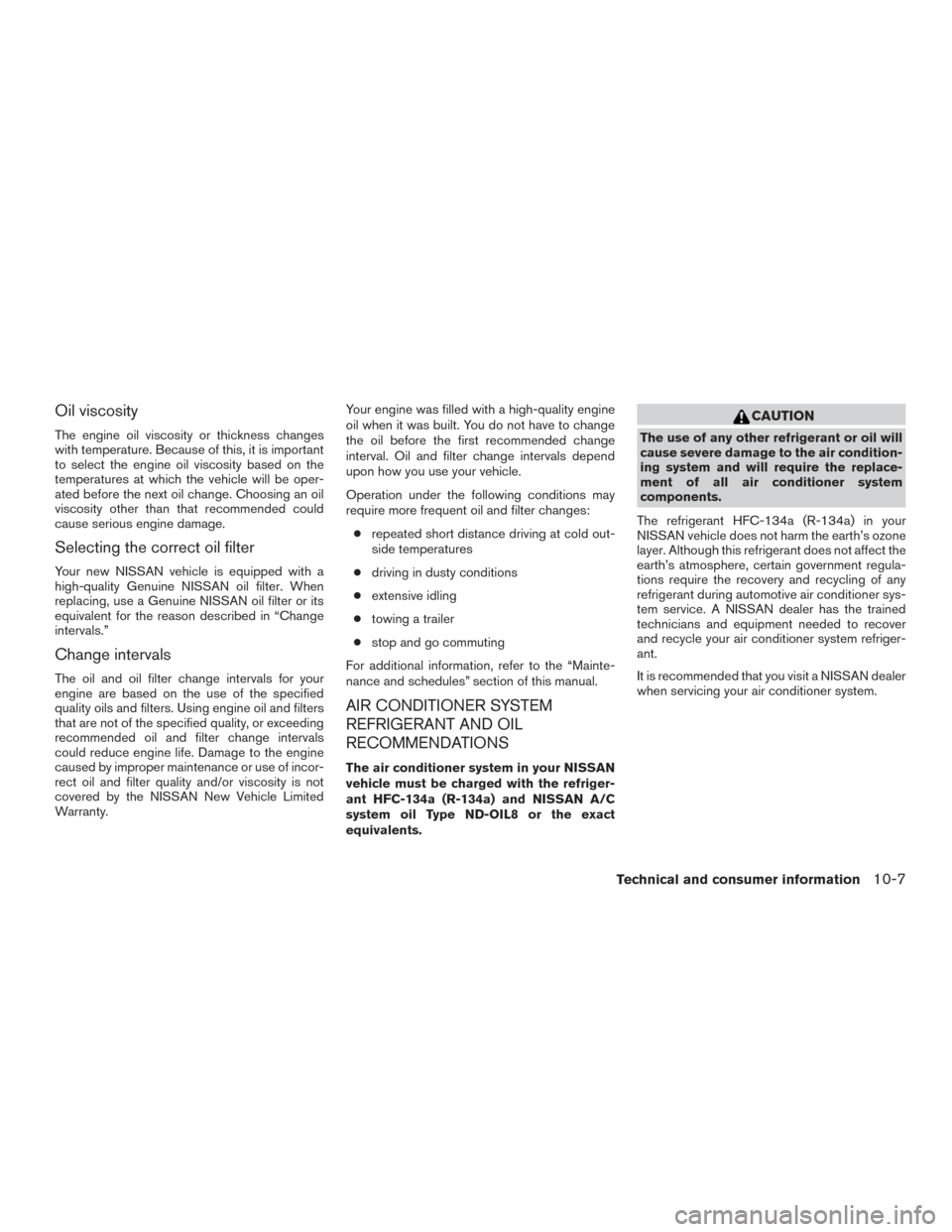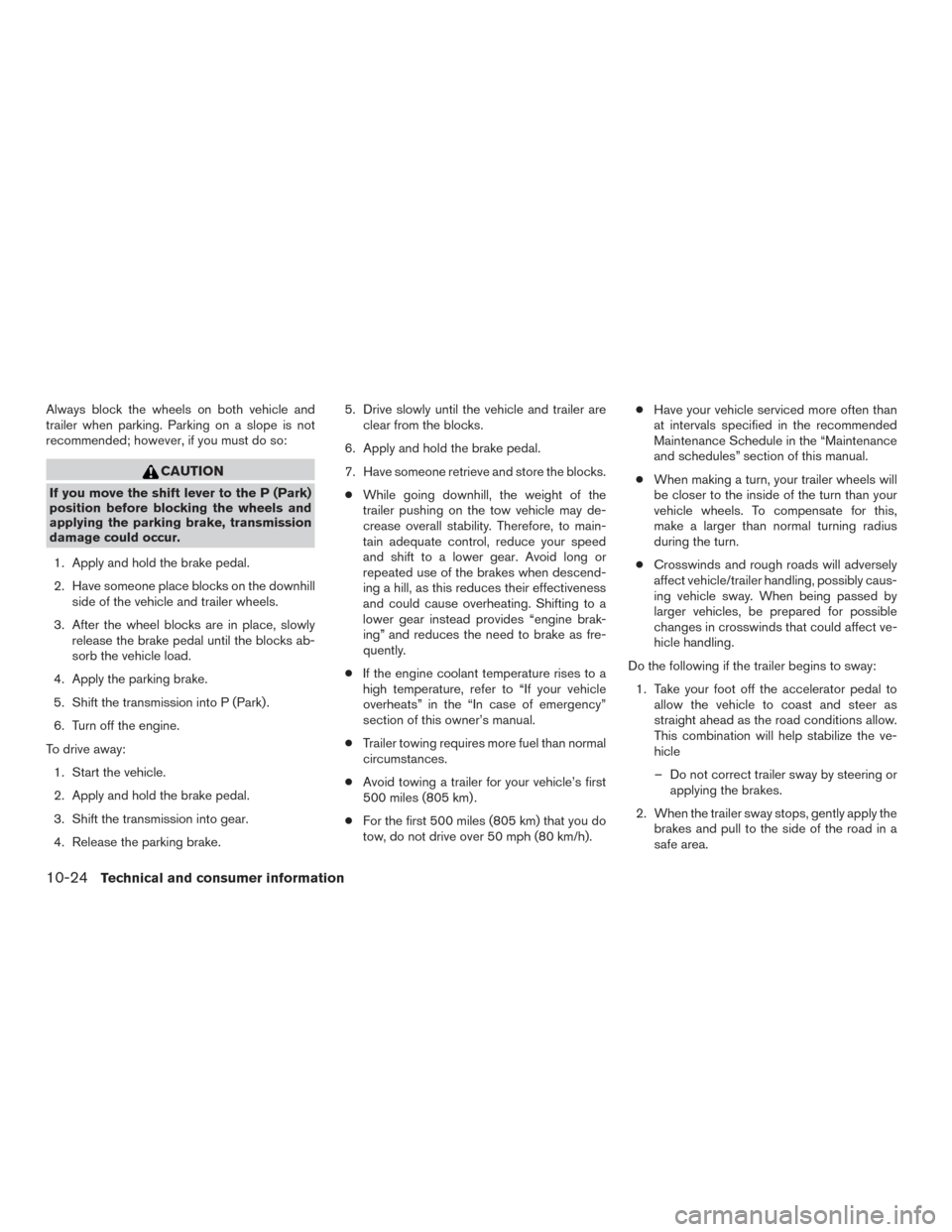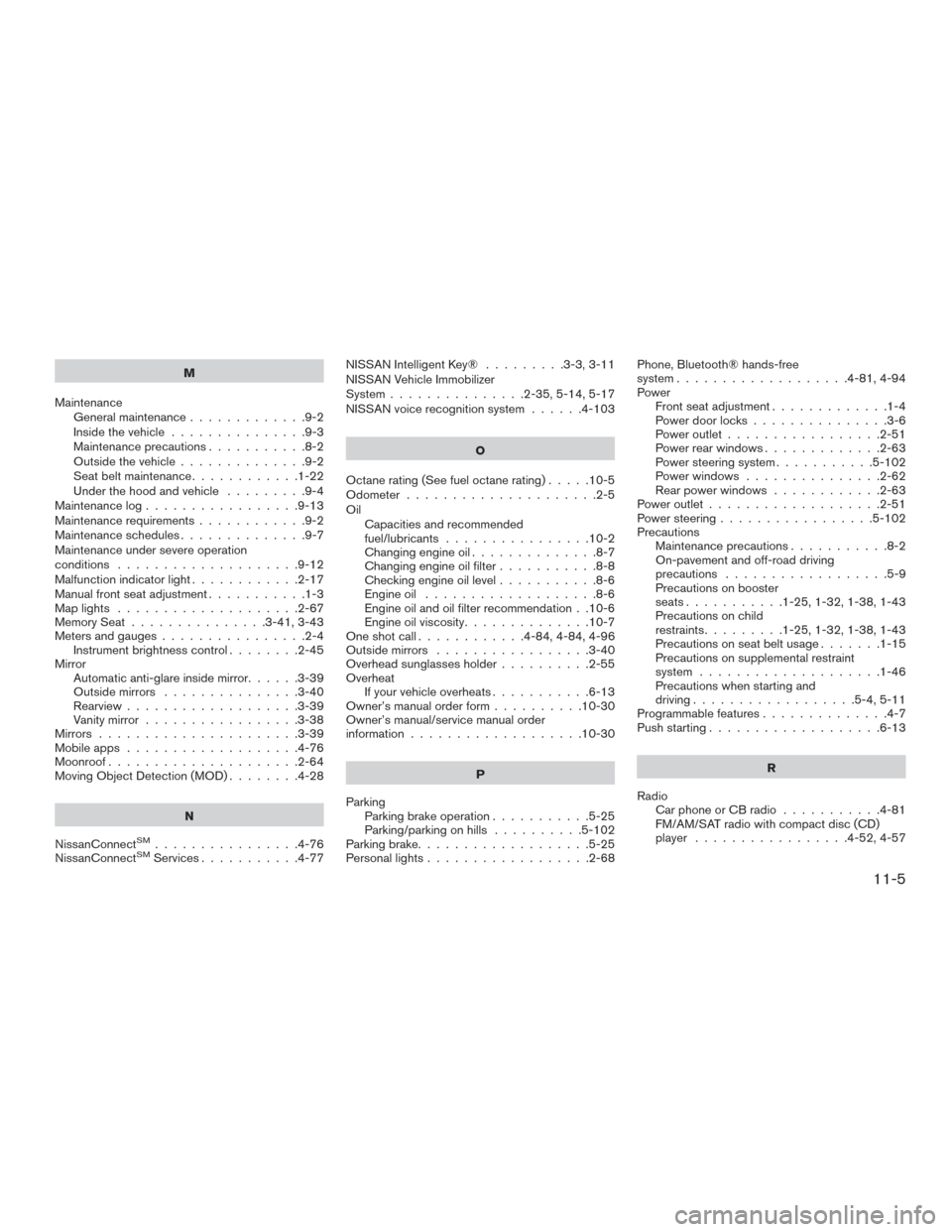2017 NISSAN ROGUE maintenance schedule
[x] Cancel search: maintenance schedulePage 514 of 547

Oil viscosity
The engine oil viscosity or thickness changes
with temperature. Because of this, it is important
to select the engine oil viscosity based on the
temperatures at which the vehicle will be oper-
ated before the next oil change. Choosing an oil
viscosity other than that recommended could
cause serious engine damage.
Selecting the correct oil filter
Your new NISSAN vehicle is equipped with a
high-quality Genuine NISSAN oil filter. When
replacing, use a Genuine NISSAN oil filter or its
equivalent for the reason described in “Change
intervals.”
Change intervals
The oil and oil filter change intervals for your
engine are based on the use of the specified
quality oils and filters. Using engine oil and filters
that are not of the specified quality, or exceeding
recommended oil and filter change intervals
could reduce engine life. Damage to the engine
caused by improper maintenance or use of incor-
rect oil and filter quality and/or viscosity is not
covered by the NISSAN New Vehicle Limited
Warranty.Your engine was filled with a high-quality engine
oil when it was built. You do not have to change
the oil before the first recommended change
interval. Oil and filter change intervals depend
upon how you use your vehicle.
Operation under the following conditions may
require more frequent oil and filter changes:
● repeated short distance driving at cold out-
side temperatures
● driving in dusty conditions
● extensive idling
● towing a trailer
● stop and go commuting
For additional information, refer to the “Mainte-
nance and schedules” section of this manual.
AIR CONDITIONER SYSTEM
REFRIGERANT AND OIL
RECOMMENDATIONS
The air conditioner system in your NISSAN
vehicle must be charged with the refriger-
ant HFC-134a (R-134a) and NISSAN A/C
system oil Type ND-OIL8 or the exact
equivalents.
CAUTION
The use of any other refrigerant or oil will
cause severe damage to the air condition-
ing system and will require the replace-
ment of all air conditioner system
components.
The refrigerant HFC-134a (R-134a) in your
NISSAN vehicle does not harm the earth’s ozone
layer. Although this refrigerant does not affect the
earth’s atmosphere, certain government regula-
tions require the recovery and recycling of any
refrigerant during automotive air conditioner sys-
tem service. A NISSAN dealer has the trained
technicians and equipment needed to recover
and recycle your air conditioner system refriger-
ant.
It is recommended that you visit a NISSAN dealer
when servicing your air conditioner system.
Technical and consumer information10-7
Page 531 of 547

Always block the wheels on both vehicle and
trailer when parking. Parking on a slope is not
recommended; however, if you must do so:
CAUTION
If you move the shift lever to the P (Park)
position before blocking the wheels and
applying the parking brake, transmission
damage could occur.1. Apply and hold the brake pedal.
2. Have someone place blocks on the downhill side of the vehicle and trailer wheels.
3. After the wheel blocks are in place, slowly release the brake pedal until the blocks ab-
sorb the vehicle load.
4. Apply the parking brake.
5. Shift the transmission into P (Park) .
6. Turn off the engine.
To drive away: 1. Start the vehicle.
2. Apply and hold the brake pedal.
3. Shift the transmission into gear.
4. Release the parking brake. 5. Drive slowly until the vehicle and trailer are
clear from the blocks.
6. Apply and hold the brake pedal.
7. Have someone retrieve and store the blocks. ● While going downhill, the weight of the
trailer pushing on the tow vehicle may de-
crease overall stability. Therefore, to main-
tain adequate control, reduce your speed
and shift to a lower gear. Avoid long or
repeated use of the brakes when descend-
ing a hill, as this reduces their effectiveness
and could cause overheating. Shifting to a
lower gear instead provides “engine brak-
ing” and reduces the need to brake as fre-
quently.
● If the engine coolant temperature rises to a
high temperature, refer to “If your vehicle
overheats” in the “In case of emergency”
section of this owner’s manual.
● Trailer towing requires more fuel than normal
circumstances.
● Avoid towing a trailer for your vehicle’s first
500 miles (805 km) .
● For the first 500 miles (805 km) that you do
tow, do not drive over 50 mph (80 km/h). ●
Have your vehicle serviced more often than
at intervals specified in the recommended
Maintenance Schedule in the “Maintenance
and schedules” section of this manual.
● When making a turn, your trailer wheels will
be closer to the inside of the turn than your
vehicle wheels. To compensate for this,
make a larger than normal turning radius
during the turn.
● Crosswinds and rough roads will adversely
affect vehicle/trailer handling, possibly caus-
ing vehicle sway. When being passed by
larger vehicles, be prepared for possible
changes in crosswinds that could affect ve-
hicle handling.
Do the following if the trailer begins to sway: 1. Take your foot off the accelerator pedal to allow the vehicle to coast and steer as
straight ahead as the road conditions allow.
This combination will help stabilize the ve-
hicle
– Do not correct trailer sway by steering or applying the brakes.
2. When the trailer sway stops, gently apply the brakes and pull to the side of the road in a
safe area.
10-24Technical and consumer information
Page 540 of 547

Engine coolant temperature gauge.......2-6
Enterbutton....................4-4
Event Data recorders .............10-29
Exhaust gas (Carbon monoxide) .........5-4
Explanation of maintenance items ........9-2
Explanation of scheduled maintenance items . .9-5
Extendedstorageswitch ............2-53
Eyeglass case ..................2-55
F
Flashers (See hazard warning flasher switch) . .6-2
Flat tire .......................6-3
Floor mat positioning aid .............7-5
Fluid Brake fluid ...................8-9
Capacities and recommended
fuel/lubricants ................10-2
Continuously Variable Transmission (CVT)
fluid.......................8-9
Engine coolant .................8-4
Engine oil ...................8-6
Windshield-washerfluid...........8-10
F.M.V.S.S. certification label ..........10-11
Foglightswitch .................2-46
Forward Emergency Braking (FEB) .......2-13
Forward Emergency Braking (FEB) with
Pedestrian Detection system ..........5-87
Front air bag system
(See supplemental restraint system) ......1-53
Front power seat adjustment ...........1-4
Frontseats.....................1-2
Fuel Capacities and recommended
fuel/lubricants ................10-2 Fuel economy
................5-98
Fuel-filler door and cap ...........3-35
Fuel gauge ...................2-7
Fuel octane rating ..............10-5
Fuel recommendation ............10-4
Loose fuel cap warning ...........2-31
Fuel efficient driving tips .............5-96
Fuel-filler door ...............3-34,3-34
Fuelgauge.....................2-7
Fuses.......................8-18
Fusiblelinks ...................8-19
G
Garage door opener, HomeLink® Universal
Transceiver ......2-69,2-70,2-71,2-72,2-72
Gascap .....................3-35
Gauge Engine coolant temperature gauge .....2-6
Fuel gauge ...................2-7
Odometer ...................2-5
Speedometer .................2-4
Tachometer ..................2-6
Trip odometer .................2-5
General maintenance ...............9-2
Glovebox.....................2-54
H
Hands-free phone system,
Bluetooth®................4-81,4-94
Hazard warning flasher switch ..........6-2
Headlight aiming control .........2-43,2-44
Headlight and turn signal switch ........2-39Headlightcontrolswitch ............2-39
Headlights....................8-26
Headlights, aiming control
........2-43,2-44
Head restraints ..................1-10
Heated seats ...................2-47
Heated steering wheel switch .........2-48
Heater Heater and air conditioner
controls ................4-33,4-41
Heater operation ...........4-34,4-42
Hill start assist system .............5-110
HomeLink® Universal
Transceiver......2-69,2-70,2-71,2-72,2-72
H
ood.......................3-26
Hook Luggage hook ................2-59
Horn .......................2-46
I
Ignition switch ..................5-13
Ignition Switch Push-Button Ignition Switch ........5-14
Immobilizer system .........2-35,5-14,5-17
Important vehicle information label ......10-11
In-cabin microfilter ................8-15
Increasing fuel economy .............5-98
Indicator lights and audible reminders
(See warning/indicator lights and audible
reminders).................2-12,2-17
Information display ................2-20
Inside automatic anti-glare mirror ........3-39
Instrument brightness control ..........2-45
Instrumentpanel...............0-6,2-2
Instrument panel dimmer switch ........2-45
11-3
Page 542 of 547

M
Maintenance General maintenance .............9-2
Insidethevehicle...............9-3
Maintenance precautions ...........8-2
Outside the vehicle ..............9-2
Seat belt maintenance ............1-22
Under the hood and vehicle .........9-4
Maintenance log .................9-13
Maintenance requirements ............9-2
Maintenance schedules ..............9-7
Maintenance under severe operation
conditions ....................9-12
Malfunction indicator light ............2-17
Manual front seat adjustment ...........1-3
Maplights ....................2-67
Memory Seat ...............3-41,3-43
Meters and gauges ................2-4
Instrument brightness control ........2-45
Mirror Automatic anti-glare inside mirror ......3-39
Outside mirrors ...............3-40
Rearview ...................3-39
Vanity mirror .................3-38
Mirrors ......................3-39
Mobileapps ...................4-76
Moonroof .....................2-64
Moving Object Detection (MOD) ........4-28
N
NissanConnect
SM................4-76
NissanConnectSMServices...........4-77 NISSAN Intelligent Key®
.........3-3,3-11
NISSAN Vehicle Immobilizer
System ...............2-35,5-14,5-17
NISSAN voice recognition system ......4-103
O
Octane rating (See fuel octane rating) .....10-5
Odometer .....................2-5
Oil Capacities and recommended
fuel/lubricants ................10-2
Changingengineoil..............8-7
Changing engine oil filter ...........8-8
Checking engine oil level ...........8-6
Engine oil ...................8-6
Engine oil and oil filter recommendation . .10-6
Engine oil viscosity ..............10-7
Oneshotcall............4-84,4-84,4-96
Outside mirrors .................3-40
Overhead sunglasses holder ..........2-55
Overheat If your vehicle overheats ...........6-13
Owner’s manual order form ..........10-30
Owner’s manual/service manual order
information ...................10-30
P
Parking Parking brake operation ...........5-25
Parking/parking on hills ..........5-102
Parking brake ...................5-25
Personallights..................2-68 Phone, Bluetooth® hands-free
system
...................4-81,4-94
Power Front seat adjustment .............1-4
Powerdoorlocks...............3-6
Power outlet .................2-51
Power rear windows .............2-63
Power steering system ...........5-102
Power windows ...............2-62
Rear power windows ............2-63
Power outlet ...................2-51
Power steering .................5-102
Precautions Maintenance precautions ...........8-2
On-pavement and off-road driving
precautions ..................5-9
Precautions on booster
seats ...........1-25,1-32,1-38,1-43
Precautions on child
restraints .........1-25,1-32,1-38,1-43
Precautions on seat belt usage .......1-15
Precautions on supplemental restraint
system ....................1-46
Precautions when starting and
driving ..................5-4,5-11
Programmable features ..............4-7
Push starting ...................6-13
R
Radio CarphoneorCBradio ...........4-81
FM/AM/SAT radio with compact disc (CD)
player .................4-52,4-57
11-5